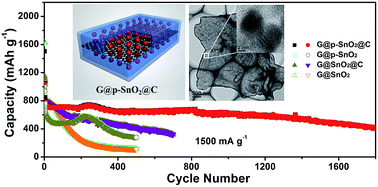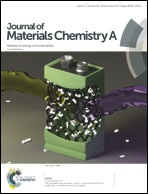Encapsulating porous SnO2 into a hybrid nanocarbon matrix for long lifetime Li storage†
Abstract
To overcome the low conductivity and large volume variation of metal oxide anodes, the electrode microstructure design for these metal oxides appeared to be the most promising strategy for achieving the desired Li storage performance. In this article, we report on a rational design of the carbon/SnO2 microstructure, in which porous SnO2 nanoparticles are encapsulated into the graphene matrix and additional carbon coating layer. As an anode material for LIBs, the as-prepared G@p-SnO2@C composite exhibited an ultra-long cycling life up to 1800 cycles. It can sustain high specific capacities of 602 and 418 mA h g−1 at 1.5 A g−1 after 1000 and 1800 cycles, respectively. The excellent battery performance could be attributed to the unique architecture of this composite, which enhances electrical conductivity, provides sufficient interior void space to accommodate the volume variation of SnO2, mitigates the aggregation, and preserves the integrity of electrodes during cycling.



 Please wait while we load your content...
Please wait while we load your content...